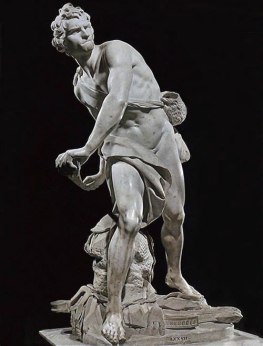Bernini’s David
Bernini’s David is another great iteration of the heroic biblical character, David. The marble sculpture was created between 1623 and 1624 in Rome, Italy. It stands about 67 inches high. In the sculpture, David is in the act of throwing. Note that this is vastly different than the previous iterations of David, but more on that later. The statue was one of many commissions to decorate the Galleria Borghese in Rome, Italy. According to the records, Bernini started his David in mid-1623 and his biographer, Filippo Baldinucci, stated that he had finished the piece in seven months.
Bernini was young when he started David, only 24 years of age. But he had huge backing from Cardinal Scipione Borghese, who could be considered religious royalty. In fact, as a huge patron for the arts, Cardinal Scipione Borghese had the sculpture commissioned for the Galleria Borghese. Bernini had actually stopped working on his current work Apollo and Daphne to work on David. With this, one could say that Scipione Borghese had a large influence in whether Bernini created David. Also, before Bernini was finished with David, his good friend, Maffeo Barberini was elected pope, as Pope Urban VIII. Since Pope Urban VIII also being a strong patron of the arts, he influenced and encouraged Bernini on his works. This tells us why Bernini created David, but not how he created it or what influenced the actual subject matter. To this we turn to the Council of Trent. Bernini was a strong devout Catholic and the Council of Trent indirectly shaped the subject of his artwork and, in turn, David. Bernini attended mass every day and took communion twice a week. Bernini agreed with the ideas of the Council of Trent. The Encyclopedia Britannica sums it up nicely. “He would agree with the formulations of the Council of Trent (1545–63) that the purpose of religious art was to teach and inspire the faithful and to serve as propaganda for the Roman Catholic Church. Religious art should always be intelligible and realistic, and, above all, it should serve as an emotional stimulus to piety. The development of Bernini’s religious art was largely determined by his conscientious efforts to conform to those principles” (Hibbard). Overall, Bernini’s David had a large influence by outside forces whether it be the religious “royalty” promoting the arts and advocating for Bernini to create David or whether it be the Council and Trent and even the Catholic Church as a whole influencing a young Bernini as a person and, in turn, influencing the artwork he created.
Bernini’s David is vastly different from Michelangelo’s David and it is hard, if I was comparing them (which I will do in a second), to whose is better. Overall, the artwork, visual, is phenomenal of course. The physiology of the sculpture is amazing. It is quite an impressive sculpture considering that “action shots” although sometimes painted, were not usually sculpted. In terms of difficulty, I think Bernini’s David was much harder to sculpt than Michelangelo’s due to the movement and the action of the piece. I would say, though, that Michelangelo’s execution, in my opinion, is better than Bernini’s. Michelangelo’s detail is finer on a much larger piece, although it is a possibility that this is not what Bernini wanted in his piece.
Bernini’s David and Michelangelo’s David are fascinatingly different. The first thing to notice in Bernini’s sculpture compared to Michelangelo’s is that David is depicted in the act of throwing the stone instead of before the act, like Michelangelo’s sculpture. This shows the changing of eras in which the two different David’s were created. First, Michelangelo’s David was created when humanism and new ways of thinking were on the rise. This is depicted strongly in the facial expression of the sculpture. Michelangelo’s David has a furrowed look on his face indicating that he is thinking before the fight with Goliath. This idea of thinking in a new way, or “work smarter not harder”, was a theme of the Italian Renaissance era and is seen heavily in Michelangelo’s work. On the other hand, Bernini’s David is depicted in the action of throwing the stone. Although this might not have been Bernini’s intention, but the sculpture could symbolically represent a push back to the old Catholic ways, back to “taking a leap of faith” mentality. David in Bernini’s piece is in the act of throwing so we do not know whether he thought about his decision or he just let God help him in his action. Experts say that the clothing in Bernini’s sculpture is God’s will and help around him. Although unlikely, Bernini’s David could have also been a literal attempt to “one-up” Michelangelo’s David. Overall, both works are absolutely amazing and it is truly an honor to have seen, analyzed, and written about these two works of art. I hope these sculptures last for many millennia to come and I hope to one day see both of these works in person.
Works Cited
“Bernini’s David.” Bernini. Khan Academy, n.d. Web. 23 June 2014. <http://smarthistory.khanacademy.org/Bernini-David.html>.
“David (Bernini).” Wikipedia. Wikimedia Foundation, 20 June 2014. Web. 23 June 2014. <http://en.wikipedia.org/wiki/David_%28Bernini%29>.
“David (Michelangelo).” Wikipedia. Wikimedia Foundation, 06 Oct. 2014. Web. 12 June 2014. <http://en.wikipedia.org/wiki/David_%28Michelangelo%29>.
Hibbard, Howard. “Patronage of Urban VIII.” Encyclopedia Britannica Online. Encyclopedia Britannica, 30 Oct. 2013. Web. 23 June 2014. <http://www.britannica.com/EBchecked/topic/62547/Gian-Lorenzo-Bernini/8222/Patronage-of-Urban-VIII>.
McClinton, Brian. “Michelangelo’s David.” Humanism Ireland • No 117 • July-August 2009 Humanist Masterpieces (n.d.): n. pag. Humanism Ireland. Web. 12 June 2014. <http://www.humanistni.org/filestore/file/david%20michelangelo.pdf>.
“Michelangelo, David.” Khan Academy. N.p., n.d. Web. 13 June 2014. <https://www.khanacademy.org/humanities/art-history/art-history-1500-1600-end-of-the-renaissance-and-the-reformation/high-renaissance/v/michelangelo–david–marble–1501-04–galleria-dell-accademia–florence>.

I love the action in this statue. The dramatic and sharp lines of David’s arm across his body and his robe across him give such a great illusion of movement. I wonder if when people come to view this statue they subconsciously stand out of the way of David’s impending throw.